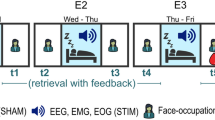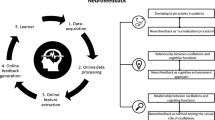Abstract
Neural networks interaction was studied in healthy men (20–35 years old) who underwent 20 sessions of EEG biofeedback training outside the MRI scanner, with concurrent fMRI–EEG scans at the beginning, middle, and end of the course. The study recruited 35 subjects for EEG biofeedback, but only 18 of them were considered as “successful” in self-regulation of target EEG bands during the whole course of training. Results of fMRI analysis during EEG biofeedback are reported only for these “successful” trainees. The experimental group (N = 23 total, N = 13 “successful”) upregulated the power of alpha rhythm, while the control group (N = 12 total, N = 5 “successful”) beta rhythm, with the protocol instructions being as for alpha training in both. The acquisition of the stable skills of alpha self-regulation was followed by the weakening of the irrelevant links between the cerebellum and visuospatial network (VSN), as well as between the VSN, the right executive control network (RECN), and the cuneus. It was also found formation of a stable complex based on the interaction of the precuneus, the cuneus, the VSN, and the high level visuospatial network (HVN), along with the strengthening of the interaction of the anterior salience network (ASN) with the precuneus. In the control group, beta enhancement training was accompanied by weakening of interaction between the precuneus and the default mode network, and a decrease in connectivity between the cuneus and the primary visual network (PVN). The differences between the alpha training group and the control group increased successively during training. Alpha training was characterized by a less pronounced interaction of the network formed by the PVN and the HVN, as well as by an increased interaction of the cerebellum with the precuneus and the RECN. The study demonstrated the differences in the structure and interaction of neural networks involved into alpha and beta generating systems forming and functioning, which should be taken into account during planning neurofeedback interventions. Possibility of using fMRI-guided biofeedback organized according to the described neural networks interaction may advance more accurate targeting specific symptoms during neurotherapy.



Similar content being viewed by others
References
Arns, M., Conners, C. K., & Kraemer, H. C. (2013). A decade of EEG theta/beta ratio research in ADHD: A meta-analysis. Journal of Attention Disorders, 17(5), 374–383.
Arns, M., de Ridder, S., Strehl, U., Breteler, M., & Coenen, A. (2009). Efficacy of neurofeedback treatment in ADHD: The effects on inattention, impulsivity and hyperactivity: A meta-analysis. Clinical EEG and Neuroscience, 40(3), 180–189.
Baehr, E., Rosenfeld, J. P., & Baehr, R. (2001). Clinical use of an alpha asymmetry neurofeedback protocol in the treatment of mood disorders: Follow-up study one to five years post therapy. Journal of Neurotherapy, 4(4), 11–18.
Bowman, A. D., Griffis, J. C., Visscher, K. M., Dobbins, A. C., Gawne, T. J., DiFrancesco, M. W., et al. (2017). Relationship between alpha rhythm and the default mode network: An EEG-fMRI study. Journal of Clinical Neurophysiology, 234(6), 527–533.
Clemente, M., Rey, B., Rodríguez-Pujadas, A., Barrós-Loscertales, A., Baños, R. M., Botella, C., et al. (2014). An fMRI study to analyze neural correlates of presence during virtual reality experiences. Interacting with Computers, 26(3), 269–284.
de Munck, J. C., Gonçalves, S. I., Huijboom, L., Kuijer, J. P., Pouwels, P. J., Heethaar, R. M., et al. (2007). The hemodynamic response of the alpha rhythm: An EEG/fMRI study. Neuroimage, 35(3), 1142–1151.
Feige, B., Scheffler, K., Esposito, F., Di Salle, F., Hennig, J., & Seifritz, E. (2005). Cortical and subcortical correlates of electroencephalographic alpha rhythm modulation. Journal of Neurophysiology, 93(5), 2864–2872.
Goldman, R. I., Stern, J. M., Engel, J. Jr., & Cohen, M. S. (2002). Simultaneous EEG and fMRI of the alpha rhythm. Neuroreport, 13(18), 2487–2492.
Greicius, M. (2017, September 12). Functional imaging in neuropsychiatric disorders lab. Retrieved from http://findlab.stanford.edu/functional_ROIs.html.
Hammond, D. C. (2005). Neurofeedback with anxiety and affective disorders. Child & Adolescent Psychiatric Clinics of North America, 14(1), 105–123.
Hlinka, J., Alexakis, C., Diukova, A., Liddle, P. F., & Auer, D. P. (2010). Slow EEG pattern predicts reduced intrinsic functional connectivity in the default mode network: An inter-subject analysis. Neuroimage, 53(1), 239–246.
Jann, K., Dierks, T., Boesch, C., Kottlow, M., Strik, W., & Koenig, T. (2009). BOLD correlates of EEG alpha phase locking and the fMRI default mode network. Neuroimage, 45(3), 903–916.
Jensen, M. P., Grierson, C., Tracy-Smith, V., Bacigalupi, S. C., & Othmer, S. (2007). Neurofeedback treatment for pain associated with complex regional pain syndrome. Journal of Neurotherapy, 11(1), 45–53.
Kozlova, L. I., Shtark, M. B., Mel’nikov, M. E., Verevkin, E. G., Savelov, A. A., & Petrovskii, E. D. (2016). EEG-fMRI study of alpha-stimulation neurobiofeedback training course. Bulletin of Experimental Biology and Medicine, 161(5), 623–628.
Laufs, H., Holt, J. L., Elfont, R., Krams, M., Paul, J. S., Krakow, K., et al. (2006). Where the BOLD signal goes when alpha EEG leaves. Neuroimage, 31(4), 1408–1418.
Laufs, H., Kleinschmidt, A., Beyerle, A., Eger, E., Salek-Haddadi, A., Preibisch, C., et al. (2003). EEG-correlated fMRI of human alpha activity. Neuroimage, 19(4), 1463–1476.
Lubar, J. F. (2003). Neurofeedback for the management of attention-deficit/hyperactivity disorders. In M. S. Schwartz & F. Andrasik (Eds.), Biofeedback: A practitioner’s guide (3rd ed., pp. 409–437). New York: Guilford.
Mantini, D., Perrucci, M. G., Del Gratta, C., Romani, G. L., & Corbetta, M. (2007). Electrophysiological signatures of resting state networks in the human brain. Proceedings of the National Academy of Sciences of the United States of America, 104(32), 13170–13175.
Nicholson, A. A., Ros, T., Frewen, P. A., Densmore, M., Théberge, J., Kluetsch, R. C., et al. (2016). Alpha oscillation neurofeedback modulates amygdala complex connectivity and arousal in posttraumatic stress disorder. Neuroimage: Clinical, 12, 506–516.
Peniston, E. G., & Kulkosky, P. J. (1989). Alpha-theta brainwave training and beta-endorphin levels in alcoholics. Alcohol: Clinical & Experimental Research, 13(2), 271–279.
Peniston, E. G., & Kulkosky, P. J. (1991). Alpha-theta brainwave neuro-feedback therapy for Vietnam veterans with combat-related post-traumatic stress disorder. Medical Psychotherapy, 4, 47–60.
Ros, T., Théberge, J., Frewen, P. A., Kluetsch, R., Densmore, M., Calhoun, V. D., et al. (2013). Mind over chatter: Plastic up-regulation of the fMRI salience network directly after EEG neurofeedback. Neuroimage, 65, 324–335.
Rosenfeld, J. P., Cha, G., Blair, T., & Gotlib, I. (1995). Operant biofeedback control of left-right frontal alpha power differences. Biofeedback & Self-Regulation, 20, 241–258.
Sadaghiani, S., Scheeringa, R., Lehongre, K., Morillon, B., Giraud, A. L., & Kleinschmidt, A. (2010). Intrinsic connectivity networks, alpha oscillations, and tonic alertness: A simultaneous electroencephalography/functional magnetic resonance imaging study. Journal of Neuroscience, 30(30), 10243–10250.
Sherlin, L., Arns, M., Lubar, J., & Sokhadze, E. (2010). A position paper on neurofeedback for the treatment of ADHD. Journal of Neurotherapy, 14(2), 66–78.
Shtark, M. B., Verevkin, E. G., Kozlova, L. I., Mazhirina, K. G., Pokrovskii, M. A., Petrovskii, E. D., et al. (2015). Synergetic fMRI-EEG brain mapping in alpha-rhythm voluntary control mode. Bulletin of Experimental and Biological Medicine, 158(5), 644–649.
Sokhadze, T. M., Cannon, R. L., & Trudeau, D. L. (2008). EEG biofeedback as a treatment for substance use disorders: Review, rating of efficacy, and recommendations for further research. Applied Psychophysiology & Biofeedback, 33(1), 1–28.
Sterman, M. B., & Egner, T. (2006). Foundation and practice of neurofeedback for the treatment of epilepsy. Applied Psychophysiology & Biofeedback, 31(1), 21–36.
Thompson, M., & Thompson, L. (2015). The neurofeedback book: An introduction to basic concepts in applied psychophysiology (2nd ed.). Wheat Ridge, CO: Association for Applied Psychophysiology and Biofeedback.
van der Kolk, B. A., Hodgdon, H., Gapen, M., Musicaro, R., Suvak, M. K., Hamlin, E., et al. (2016). A Randomized controlled study of neurofeedback for chronic PTSD. PLoS ONE, 11(12), e0166752. https://doi.org/10.1371/journal.pone.0166752.
Acknowledgements
This study was supported by Russian Science Foundation (RSF grant N 16-15-00183).
Author information
Authors and Affiliations
Corresponding author
Ethics declarations
Conflict of interest
The authors do not have any potential conflict of interest to disclose. All authors therefore declare that they do not have any conflict of interests.
Ethical Approval
All procedures performed in this study that involved human subjects were in accordance with the ethical standards and in compliance with the 1964 Helsinki declaration and its later amendments or comparable ethical standards. The study protocol was approved by the Ethics Committee of the Research Institute of Molecular Biology and Biophysics. All subjects signed informed consent form approved by the Ethics Committee.
Rights and permissions
About this article
Cite this article
Shtark, M.B., Kozlova, L.I., Bezmaternykh, D.D. et al. Neuroimaging Study of Alpha and Beta EEG Biofeedback Effects on Neural Networks. Appl Psychophysiol Biofeedback 43, 169–178 (2018). https://doi.org/10.1007/s10484-018-9396-2
Published:
Issue Date:
DOI: https://doi.org/10.1007/s10484-018-9396-2




